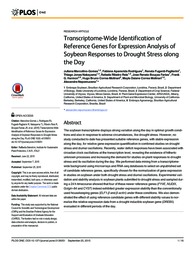Transcriptome-wide identification of reference genes for expression analysis of soybean responses to drought stress along the day.
Transcriptome-wide identification of reference genes for expression analysis of soybean responses to drought stress along the day.
Autoria: MARCOLINO-GOMES, J.; RODRIGUES, F. A.; FUGANTI-PAGLIARINI, R.; NAKAYAMA, T. J.; REIS, R. R.; FARIAS, J. R. B.; HARMON, F. G.; MOLINARI, H. B. C.; MOLINARI, M. D. C.; NEPOMUCENO, A. L.
Resumo: The soybean transcriptome displays strong variation along the day in optimal growth conditions and also in response to adverse circumstances, like drought stress. However, no study conducted to date has presented suitable reference genes, with stable expression along the day, for relative gene expression quantification in combined studies on drought stress and diurnal oscillations. Recently, water deficit responses have been associated with circadian clock oscillations at the transcription level, revealing the existence of hitherto unknown processes and increasing the demand for studies on plant responses to drought stress and its oscillation during the day. We performed data mining from a transcriptomewide background using microarrays and RNA-seq databases to select an unpublished set of candidate reference genes, specifically chosen for the normalization of gene expression in studies on soybean under both drought stress and diurnal oscillations. Experimental validation and stability analysis in soybean plants submitted to drought stress and sampled during a 24 h timecourse showed that four of these newer reference genes (FYVE, NUDIX, Golgin-84 and CYST) indeed exhibited greater expression stability than the conventionally used housekeeping genes (ELF1-β and β-actin) under these conditions. We also demonstrated the effect of using reference candidate genes with different stability values to normalize the relative expression data from a drought-inducible soybean gene (DREB5) evaluated in different periods of the day.
Ano de publicação: 2015
Tipo de publicação: Artigo de periódico
Unidade: Embrapa Soja
Palavras-chave: Drought stress, Estiagem, Resistência à seca, Seca, Soja, Soybean
Observações
1 - Por padrão são exibidas publicações dos últimos 20 anos. Para encontrar publicações mais antigas, configure o filtro ano de publicação, colocando o ano a partir do qual você deseja encontrar publicações. O filtro está na coluna da esquerda na busca acima.
2 - Para ler algumas publicações da Embrapa (apenas as que estão em formato ePub), é necessário ter, no celular ou computador, um desses softwares gratuitos. Sistemas Android: Google Play Livros; IOS: iBooks; Windows e Linux: software Calibre.
Acesse outras publicações
Acesse a Base de Dados da Pesquisa Agropecuária (BDPA) para consultar o acervo completo das bibliotecas da Embrapa.

